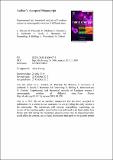Experimental and theoretical analysis of Landauer erasure in nanomagnetic switches of different sizes
Abstract
Bistable nanomagnetic switches are extensively used in storage media and magnetic memories, associating each logic state to a different equilibrium orientation of the magnetization. Here we consider the issue of the minimum energy required to change the information content of nanomagnetic switches, a crucial topic to face fundamental challenges of current technology, such as power dissipation and limits of scaling. The energy dissipated during a reset operation, also known as “Landauer erasure”, has been accurately measured at room temperature by vectorial magneto-optical measurements in arrays of elongated Permalloy nanodots. Both elliptical and rectangular dots were analysed, with lateral sizes ranging from several hundreds to a few tens of nanometers and thickness of either 10 nm or 5 nm. The experimental results show a nearly linear decrease of the dissipated energy with the dot volume, ranging from three to one orders of magnitude above the theoretical Landauer limit of kBT×ln(2). These experimental findings are corroborated by micromagnetic simulations showing that the significant deviations from the ideal macrospin behavior are caused by both inhomogeneous magnetization distribution and edge effects, leading to an average produced heat which is appreciably larger than that expected for ideal nanoswitches.
Citation
Martini , L , Pancaldi , M , Madami , M , Vavassori , P , Gubbiotti , G , Tacchi , S , Hartmann , F , Emmerling , M , Höfling , S , Worschech , L & Carlotti , G 2015 , ' Experimental and theoretical analysis of Landauer erasure in nanomagnetic switches of different sizes ' , Nano Energy , vol. In press . https://doi.org/10.1016/j.nanoen.2015.10.028
Publication
Nano Energy
Status
Peer reviewed
ISSN
2211-2855Type
Journal article
Description
The authors acknowledge support by the European Union (FPVII (2007-2013) under G.A. n.318287 LANDAUER, and by MIUR-PRIN 2010–11 Project 2010ECA8P3 “DyNanoMag.”. M.P. and P.V. acknowledge funding from the Spanish Ministry of Economy and Competitiveness (Project No. MAT2012-36844); M.P. acknowledges support by Spanish Ministry of Economy and Competitiveness (grant BES-2013-063690).Collections
Items in the St Andrews Research Repository are protected by copyright, with all rights reserved, unless otherwise indicated.

